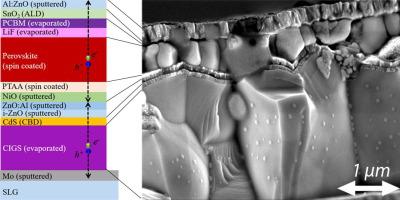当前位置:
X-MOL 学术
›
Sol. Energy
›
论文详情
Our official English website, www.x-mol.net, welcomes your
feedback! (Note: you will need to create a separate account there.)
2-Terminal CIGS-perovskite tandem cells: A layer by layer exploration
Solar Energy ( IF 6.0 ) Pub Date : 2020-09-01 , DOI: 10.1016/j.solener.2020.06.034 T. Jesper Jacobsson , Adam Hultqvist , Sebastian Svanström , Lars Riekehr , Ute B. Cappel , Eva Unger , Håkan Rensmo , Erik M.J. Johansson , Marika Edoff , Gerrit Boschloo
Solar Energy ( IF 6.0 ) Pub Date : 2020-09-01 , DOI: 10.1016/j.solener.2020.06.034 T. Jesper Jacobsson , Adam Hultqvist , Sebastian Svanström , Lars Riekehr , Ute B. Cappel , Eva Unger , Håkan Rensmo , Erik M.J. Johansson , Marika Edoff , Gerrit Boschloo

|
Abstract This paper focuses on the development of 2-terminal CIGS-perovskite tandem solar cells by exploring a range of stack sequences and synthetic procedures for depositing the associated layers. In the end, we converged at a stack sequence composed of SLG/Mo/CIGS/CdS/i-ZnO/ZnO:Al/NiO/PTAA/Perovskite/LiF/PCBM/SnO2/ITO. With this architecture, we reached performances only about 1% lower than the corresponding 4-terminal tandem cells, thus demonstrating functional interconnects between the two sub-cells while grown monolithically on top of each other. We go through the stack, layer-by-layer, discussing their deposition and the results, from which we can conclude what works, what does not work, and what potentially could work after additional modifications. The challenges for a successful 2-terminal tandem device include: how to deal with, or decrease, the surface roughness of the CIGS-stack, how to obtain uniform coverage of the layers between the CIGS and the perovskite while also obtaining a benign interface chemistry, and how to tune the band gaps of both the CIGS and the perovskite to obtain good optical matching. The investigation was based on CIGS with a power conversion efficiency around 14%, and perovskites with an efficiency around 12%, resulting in 2-terminal tandem cells with efficiencies of 15–16%. The results indicate that by using higher performing CIGS and perovskite sub-cells, it should be possible to manufacture highly efficient 2-terminal CIGS-perovskite tandem devices by using the protocols, principles, and procedures developed and discussed in this paper.
中文翻译:

2-Terminal CIGS-钙钛矿串联电池:逐层探索
摘要 本文通过探索一系列堆叠序列和用于沉积相关层的合成程序,重点关注 2 端 CIGS-钙钛矿串联太阳能电池的开发。最后,我们收敛于由 SLG/Mo/CIGS/CdS/i-ZnO/ZnO:Al/NiO/PTAA/Perovskite/LiF/PCBM/SnO2/ITO 组成的堆叠序列。使用这种架构,我们的性能仅比相应的 4 端串联电池低约 1%,从而证明了两个子电池之间的功能互连,同时彼此叠加生长。我们逐层浏览堆栈,讨论它们的沉积和结果,从中我们可以得出结论,哪些有效,哪些无效,以及经过额外修改后哪些可能有效。成功的 2 端串联设备面临的挑战包括:如何处理、或降低 CIGS 堆叠的表面粗糙度,如何在 CIGS 和钙钛矿之间获得均匀的层覆盖,同时获得良性界面化学,以及如何调整 CIGS 和钙钛矿的带隙以获得良好的光学匹配。该研究基于功率转换效率约为 14% 的 CIGS 和效率约为 12% 的钙钛矿,从而产生效率为 15-16% 的 2 端串联电池。结果表明,通过使用更高性能的 CIGS 和钙钛矿子电池,应该可以使用本文中开发和讨论的协议、原理和程序制造高效的 2 端 CIGS-钙钛矿串联器件。如何在 CIGS 和钙钛矿之间获得均匀的层覆盖,同时获得良性的界面化学,以及如何调整 CIGS 和钙钛矿的带隙以获得良好的光学匹配。该研究基于功率转换效率约为 14% 的 CIGS 和效率约为 12% 的钙钛矿,从而产生效率为 15-16% 的 2 端串联电池。结果表明,通过使用更高性能的 CIGS 和钙钛矿子电池,应该可以使用本文中开发和讨论的协议、原理和程序制造高效的 2 端 CIGS-钙钛矿串联器件。如何在 CIGS 和钙钛矿之间获得均匀的层覆盖,同时获得良性的界面化学,以及如何调整 CIGS 和钙钛矿的带隙以获得良好的光学匹配。该研究基于功率转换效率约为 14% 的 CIGS 和效率约为 12% 的钙钛矿,从而产生效率为 15-16% 的 2 端串联电池。结果表明,通过使用更高性能的 CIGS 和钙钛矿子电池,应该可以使用本文中开发和讨论的协议、原理和程序制造高效的 2 端 CIGS-钙钛矿串联器件。以及如何调整 CIGS 和钙钛矿的带隙以获得良好的光学匹配。该研究基于功率转换效率约为 14% 的 CIGS 和效率约为 12% 的钙钛矿,从而产生效率为 15-16% 的 2 端串联电池。结果表明,通过使用更高性能的 CIGS 和钙钛矿子电池,应该可以使用本文中开发和讨论的协议、原理和程序制造高效的 2 端 CIGS-钙钛矿串联器件。以及如何调整 CIGS 和钙钛矿的带隙以获得良好的光学匹配。该研究基于功率转换效率约为 14% 的 CIGS 和效率约为 12% 的钙钛矿,从而产生效率为 15-16% 的 2 端串联电池。结果表明,通过使用更高性能的 CIGS 和钙钛矿子电池,应该可以使用本文中开发和讨论的协议、原理和程序制造高效的 2 端 CIGS-钙钛矿串联器件。
更新日期:2020-09-01
中文翻译:

2-Terminal CIGS-钙钛矿串联电池:逐层探索
摘要 本文通过探索一系列堆叠序列和用于沉积相关层的合成程序,重点关注 2 端 CIGS-钙钛矿串联太阳能电池的开发。最后,我们收敛于由 SLG/Mo/CIGS/CdS/i-ZnO/ZnO:Al/NiO/PTAA/Perovskite/LiF/PCBM/SnO2/ITO 组成的堆叠序列。使用这种架构,我们的性能仅比相应的 4 端串联电池低约 1%,从而证明了两个子电池之间的功能互连,同时彼此叠加生长。我们逐层浏览堆栈,讨论它们的沉积和结果,从中我们可以得出结论,哪些有效,哪些无效,以及经过额外修改后哪些可能有效。成功的 2 端串联设备面临的挑战包括:如何处理、或降低 CIGS 堆叠的表面粗糙度,如何在 CIGS 和钙钛矿之间获得均匀的层覆盖,同时获得良性界面化学,以及如何调整 CIGS 和钙钛矿的带隙以获得良好的光学匹配。该研究基于功率转换效率约为 14% 的 CIGS 和效率约为 12% 的钙钛矿,从而产生效率为 15-16% 的 2 端串联电池。结果表明,通过使用更高性能的 CIGS 和钙钛矿子电池,应该可以使用本文中开发和讨论的协议、原理和程序制造高效的 2 端 CIGS-钙钛矿串联器件。如何在 CIGS 和钙钛矿之间获得均匀的层覆盖,同时获得良性的界面化学,以及如何调整 CIGS 和钙钛矿的带隙以获得良好的光学匹配。该研究基于功率转换效率约为 14% 的 CIGS 和效率约为 12% 的钙钛矿,从而产生效率为 15-16% 的 2 端串联电池。结果表明,通过使用更高性能的 CIGS 和钙钛矿子电池,应该可以使用本文中开发和讨论的协议、原理和程序制造高效的 2 端 CIGS-钙钛矿串联器件。如何在 CIGS 和钙钛矿之间获得均匀的层覆盖,同时获得良性的界面化学,以及如何调整 CIGS 和钙钛矿的带隙以获得良好的光学匹配。该研究基于功率转换效率约为 14% 的 CIGS 和效率约为 12% 的钙钛矿,从而产生效率为 15-16% 的 2 端串联电池。结果表明,通过使用更高性能的 CIGS 和钙钛矿子电池,应该可以使用本文中开发和讨论的协议、原理和程序制造高效的 2 端 CIGS-钙钛矿串联器件。以及如何调整 CIGS 和钙钛矿的带隙以获得良好的光学匹配。该研究基于功率转换效率约为 14% 的 CIGS 和效率约为 12% 的钙钛矿,从而产生效率为 15-16% 的 2 端串联电池。结果表明,通过使用更高性能的 CIGS 和钙钛矿子电池,应该可以使用本文中开发和讨论的协议、原理和程序制造高效的 2 端 CIGS-钙钛矿串联器件。以及如何调整 CIGS 和钙钛矿的带隙以获得良好的光学匹配。该研究基于功率转换效率约为 14% 的 CIGS 和效率约为 12% 的钙钛矿,从而产生效率为 15-16% 的 2 端串联电池。结果表明,通过使用更高性能的 CIGS 和钙钛矿子电池,应该可以使用本文中开发和讨论的协议、原理和程序制造高效的 2 端 CIGS-钙钛矿串联器件。











































 京公网安备 11010802027423号
京公网安备 11010802027423号